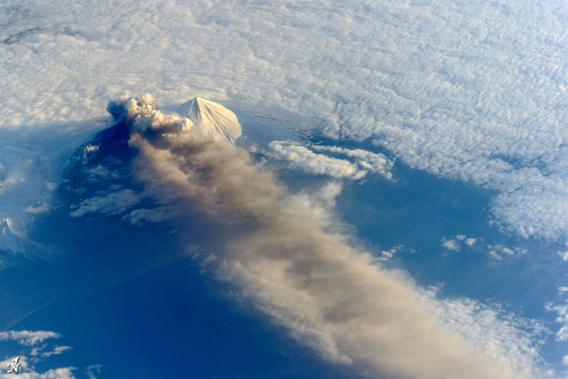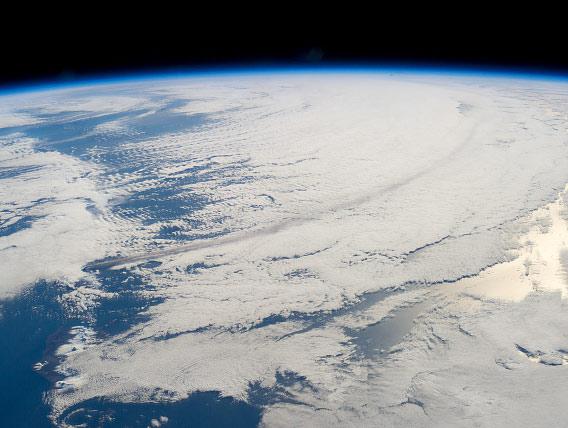The Pavlof volcano sits in the long, long chain of the Aleutian Islands off the west coast of Alaska, and is one of the most active volcanoes in the United States. It’s about seven kilometers (4 miles) across and 2500 meters (1.5 miles) high. After being quiet since 2007, it started erupting again on May 13, 2013.
A few days later, on May 18, astronauts aboard the International Space Station had this amazing view of the event:

Photo by NASA
One thing I love about photos of the Earth from ISS is that the astronauts can see things at an oblique angle. Most satellites take pictures straight down and you lose the sense of depth. The astronauts have a wider view, and can see surface features closer to the horizon. This angle can give an incredibly dramatic view like that one.
The plume of ash shot up to a height of six kilometers (almost four miles), and goes a long way. That picture above was taken using a telephoto, but a shorter lens provides a bit of context:

Photo by NASA.
WOW. The plume extends for hundreds of kilometers, blown by winds to the southeast. I don’t think I’ve ever seen a plume that long seen so clearly before.
Volcanic ash is a hazard; it’s composed not of smooth dust but of very small grains of rock that can have extremely sharp edges and ridges. Even in small quantities it can choke an airplane engine and damage windshields, so air traffic has to be routed around active volcanoes; Pavlof is creating such a situation now.
Alaska is loaded with volcanoes, many of which are active and hazardous to airplanes and people. Scientists need to observe these volcanoes constantly, keeping an eye on them in case any of them decides to wake up. However, the Alaska Volcano Observatory has had its funding cut recently; it’s been halved since 2007. Budget cuts, sequestration, and the loss of earmarks are to blame. The effect has been bad: the AVO has had to stop real-time monitoring of at least four of Alaska’s volcanoes, and much of their equipment is old and on the verge of failing, if not already malfunctioning.
I know the economy means that lots of programs get hit, but not every program the government funds is equal. The idea of cutting back on volcano observatories is, simply, nuts. People’s lives are at stake, and certainly a big eruption has economic impact. The intersection of science and public safety is not a place we can afford to cut back.
I remember, back in 2009, Louisiana governor Bobby Jindal using volcano observatories as an example of foolish spending. It’s that kind of thinking that’s foolish. Monitoring volcanoes is in everyone’s best interest, and should be a funding priority.